The standard Mazda CX-50 has carved a niche for itself as a crossover that appeals to driving enthusiasts, those who appreciate a sporty feel in a compact SUV. It’s designed for individuals who might have previously favored sports cars but now require the added practicality of an SUV. However, in a market dominated by giants like the Honda CR-V and Toyota RAV4, the CX-50 lags behind in areas such as cabin technology and fuel economy, aspects that are often top priorities for crossover buyers.
Therefore, the announcement of a Mazda CX-50 Hybrid was met with considerable optimism. The promise was to retain the beloved driving dynamics of the CX-50 while addressing its shortcomings with an efficient hybrid powertrain. Electrification combined with Mazda’s renowned chassis, suspension, and steering seemed like a winning formula.
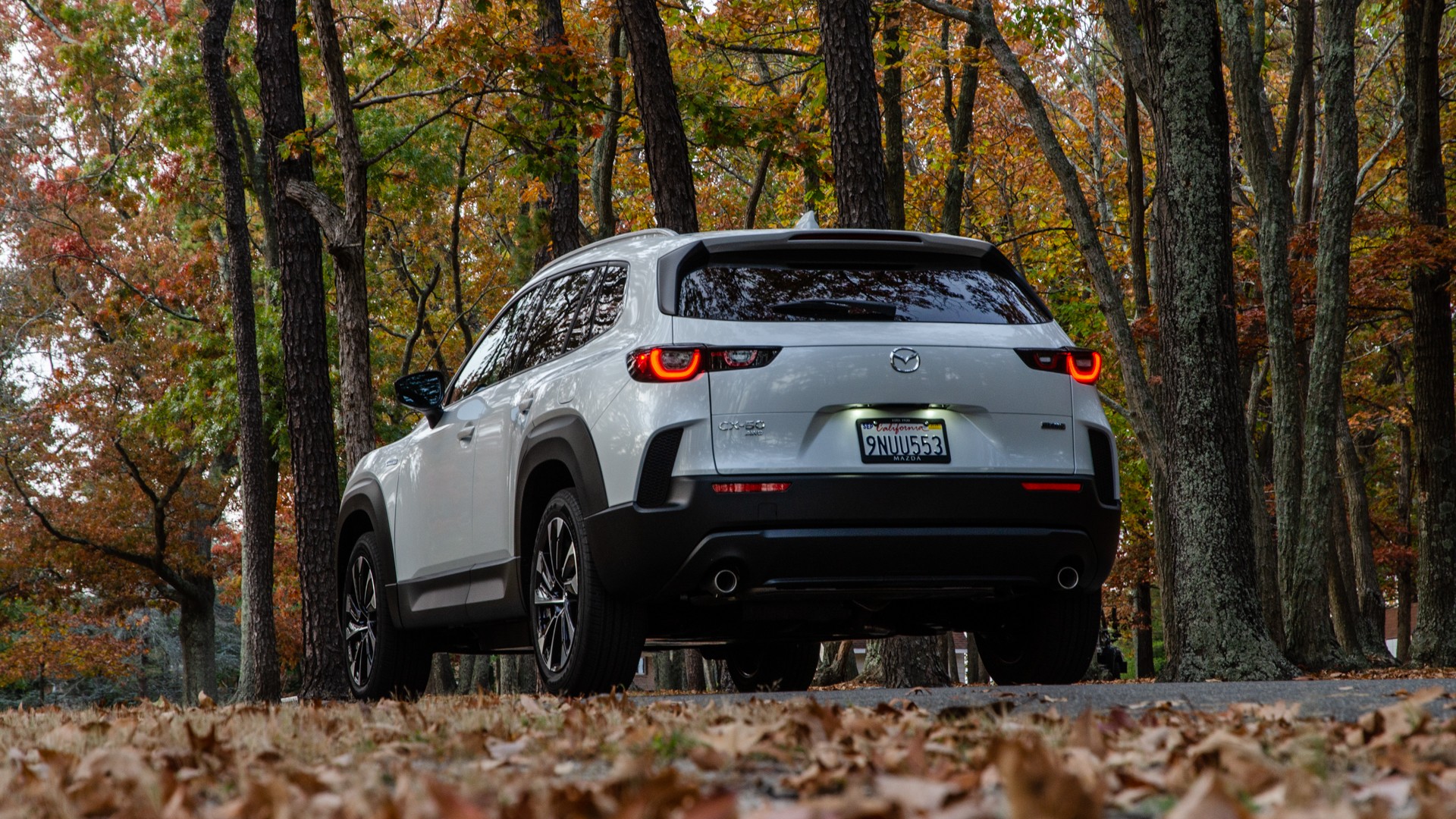 2025 Mazda CX-50 Hybrid exterior front view
2025 Mazda CX-50 Hybrid exterior front view
Unfortunately, after getting behind the wheel, the 2025 Mazda CX-50 Hybrid proves to be less compelling in reality than it appears on paper. While it maintains many of the appealing qualities of its gas-powered sibling and competes well in many aspects with rivals, the Toyota RAV4-sourced hybrid powertrain feels somewhat out of sync with the CX-50’s character. It’s as if the hybrid system dilutes the very essence that makes the CX-50 special, leaving it in a somewhat confusing position.
Design and Interior: Familiar Mazda Aesthetics (Good and Bad)
Mazda opted for a strategic partnership with Toyota, utilizing components from the RAV4 Hybrid for the CX-50 Hybrid’s powertrain rather than developing their own system from scratch. This collaboration stems from a broader alliance between the two automakers, with the CX-50 being manufactured alongside Toyota vehicles, including the Corolla Cross Hybrid, at a shared facility in Alabama. Beyond the powertrain, the CX-50 Hybrid remains largely unchanged from its standard counterpart. Visual distinctions are subtle, limited to hybrid badging and a revised instrument cluster where a battery charge/power gauge replaces the traditional tachometer.
Exterior Design: Still a Looker
If not for the discreet “Hybrid” badges, distinguishing this model from the regular CX-50 would be challenging. This is largely a positive aspect, as the CX-50 has been praised for its attractive design since its introduction. It stands out in its segment with a low-slung, muscular stance that exudes a sportier vibe than many of its competitors. The signature design elements, including the robust wheel arches, low ride height, sleek window lines, and black body cladding, are all present, ensuring the hybrid variant retains the same visual appeal. While new wheel designs are introduced, they maintain a similar aesthetic to other CX-50 wheel options, keeping the overall look cohesive.
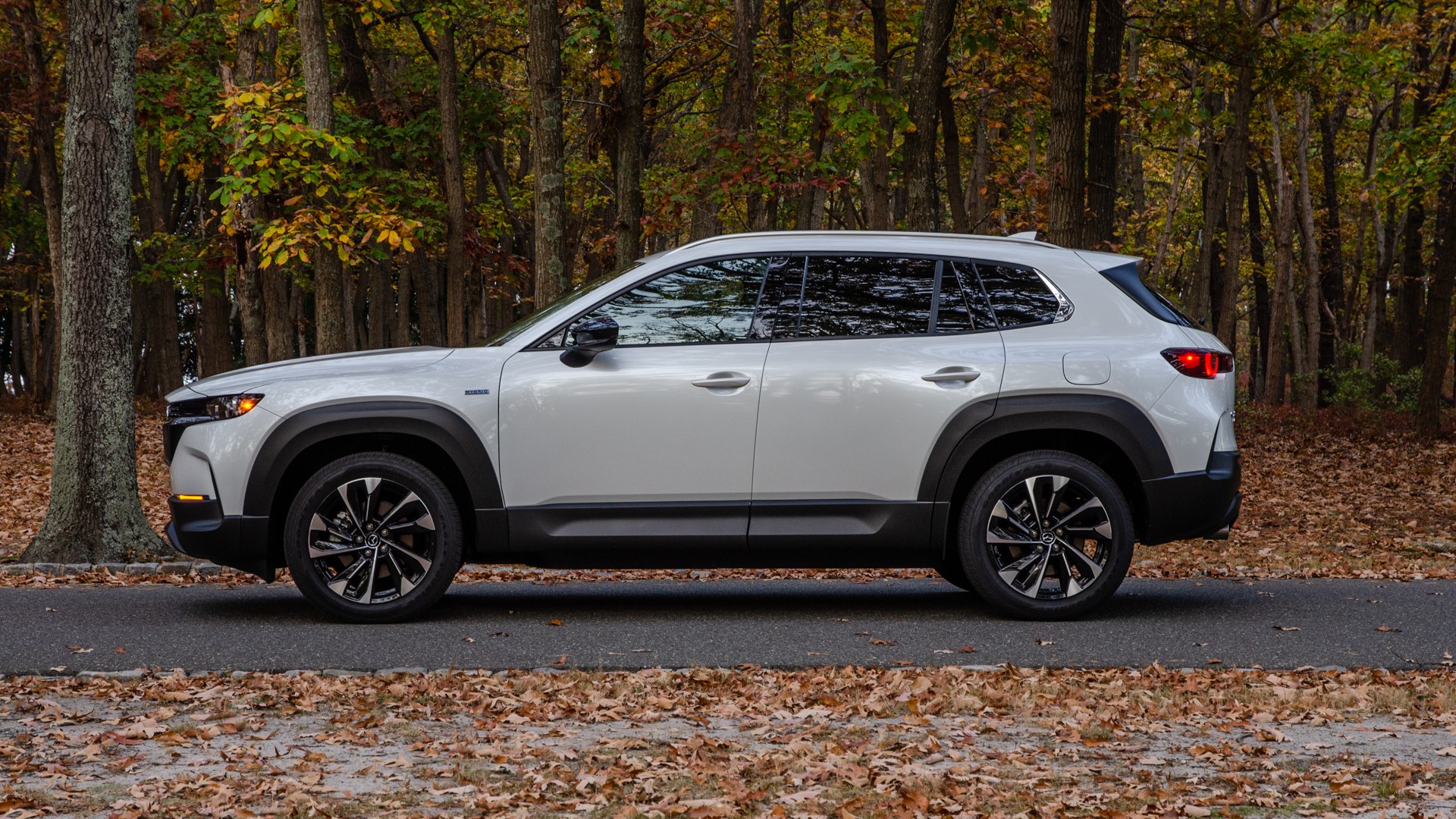 Side profile of 2025 Mazda CX-50 Hybrid showcasing wheel design
Side profile of 2025 Mazda CX-50 Hybrid showcasing wheel design
Interior: Driver-Centric but Dated Tech
The interior of the Mazda CX-50 Hybrid mirrors the standard model closely, preserving its driver-focused and sporty cabin ambiance. This consistency has both advantages and disadvantages. The upside is the continuation of a well-constructed, ergonomically sound interior that feels intuitively designed for those who appreciate driver-oriented vehicles. However, the downside is the carryover of the infotainment system, which feels noticeably outdated compared to contemporary systems. This technological lag might be a point of disappointment for buyers expecting cutting-edge features, especially considering the price point aligns with competitors offering more advanced technology.
As noted, the tachometer is replaced with hybrid-specific gauges. However, the information provided is quite basic, primarily indicating battery usage and charging status. It lacks the detailed power flow diagrams commonly found in the RAV4 and CR-V Hybrids. Enthusiasts who enjoy delving into the intricacies of hybrid vehicle technology might find the CX-50 Hybrid’s instrumentation less informative than desired.
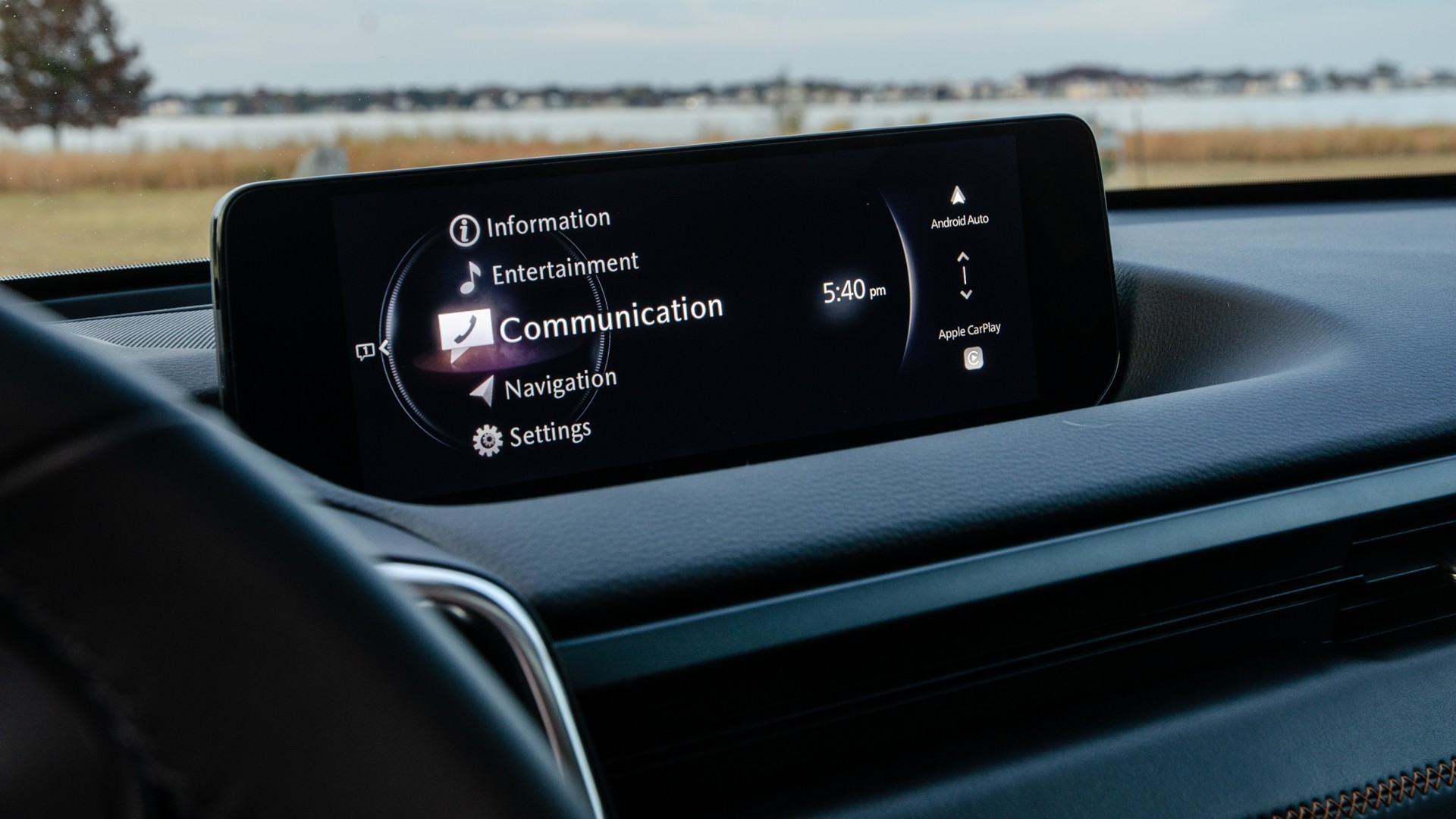 Mazda CX-50 Hybrid interior dashboard and gauge cluster
Mazda CX-50 Hybrid interior dashboard and gauge cluster
Driving Performance: Hybrid Powertrain Impact
The Toyota-sourced hybrid powertrain takes center stage in the CX-50 Hybrid, significantly shaping its driving experience, for better and for worse. It combines a 2.5-liter Atkinson cycle, naturally aspirated four-cylinder engine with three AC motors—two supporting the engine and one powering the rear axle. The combined system output is rated at 219 horsepower and 163 lb-ft of torque. Notably, this makes it the least powerful variant in the CX-50 lineup, a characteristic that is palpable behind the wheel. Regardless of speed or throttle input, the powertrain feels underpowered, and the droning nature of the continuously variable automatic transmission (CVT) further detracts from the driving enjoyment.
Engine and Performance: Underwhelming Power
While expectations for sports car-like acceleration were not in place for the CX-50 Hybrid, the actual powertrain performance proves to be disappointingly uninspiring. The engine feels coarse and lacks responsiveness, making each drive somewhat underwhelming. On the positive side, the focus on efficiency yields impressive fuel economy figures. During the testing period, an average of around 37 mpg was observed, closely aligning with Mazda’s official claims.
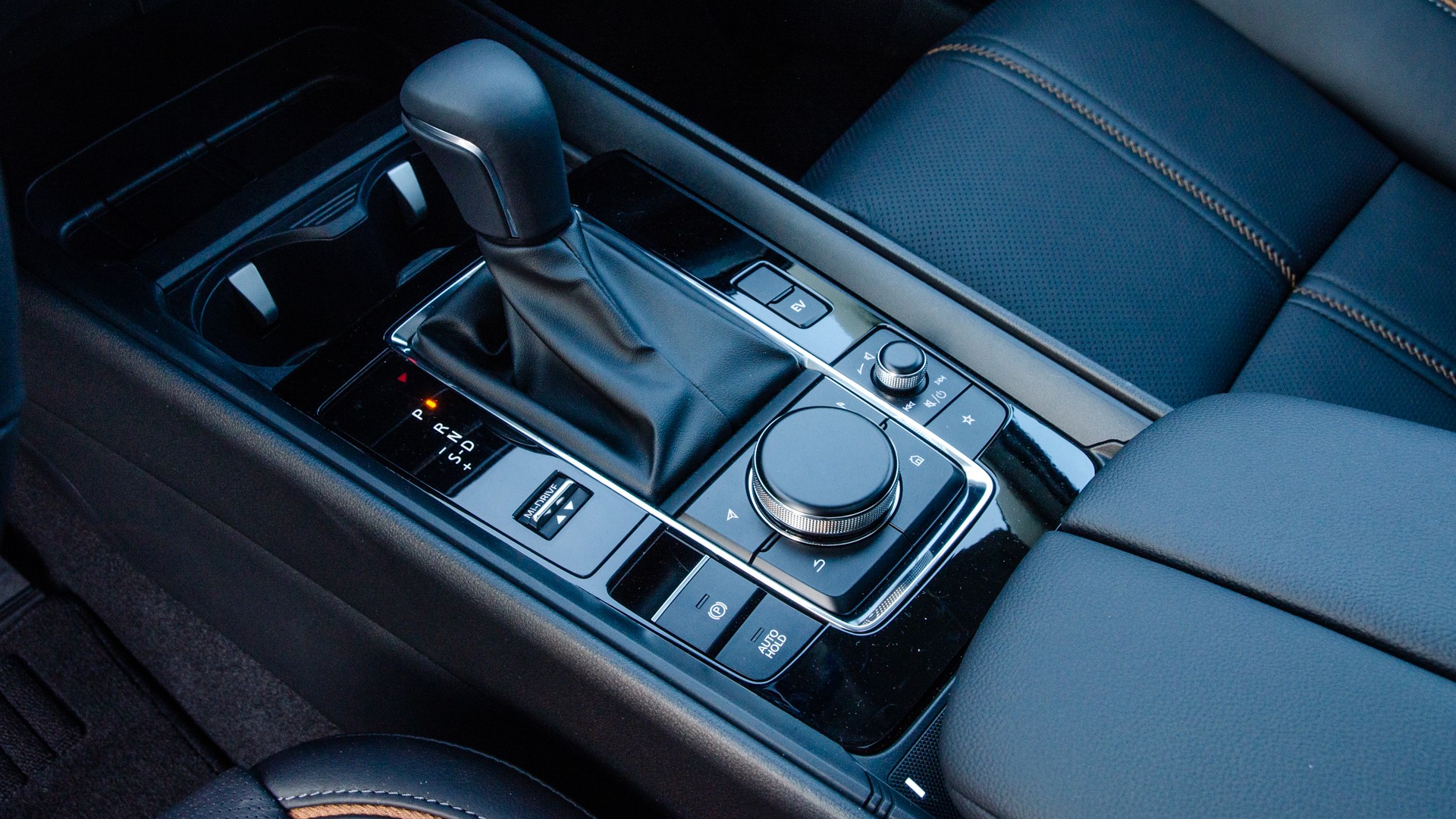 Mazda CX-50 Hybrid driving on a scenic road
Mazda CX-50 Hybrid driving on a scenic road
Handling and Ride: Retains Mazda’s DNA
The standard CX-50 is celebrated for its agility and engaging driving dynamics, setting it apart from many crossovers in its class. It boasts exceptional steering feel and well-balanced handling, reminiscent of a sports car in SUV form. Remarkably, the Hybrid version retains these desirable traits. When navigating winding roads, the CX-50 Hybrid exhibits the same level of poise and responsiveness as its gas-powered siblings. However, the limitation arises when attempting to capitalize on this agility with spirited acceleration. The powertrain’s lack of punch becomes evident, hindering the overall driving enjoyment when pushing for performance. Despite its athletic handling capabilities, the powertrain’s sluggishness prevents it from fully realizing its sporty potential.
Despite the powertrain’s shortcomings, Mazda’s expertise in suspension tuning shines through in the Hybrid model. It delivers a ride quality that is just as refined and comfortable as the gas-only CX-50 variants. The brakes are also commendable, offering good pedal feel and immediate response. Visibility remains good, making it easy to maneuver and place the vehicle accurately on the road. For those who appreciate the driving feel of the standard CX-50, the Hybrid will likely appeal, up to the point of demanding more power.
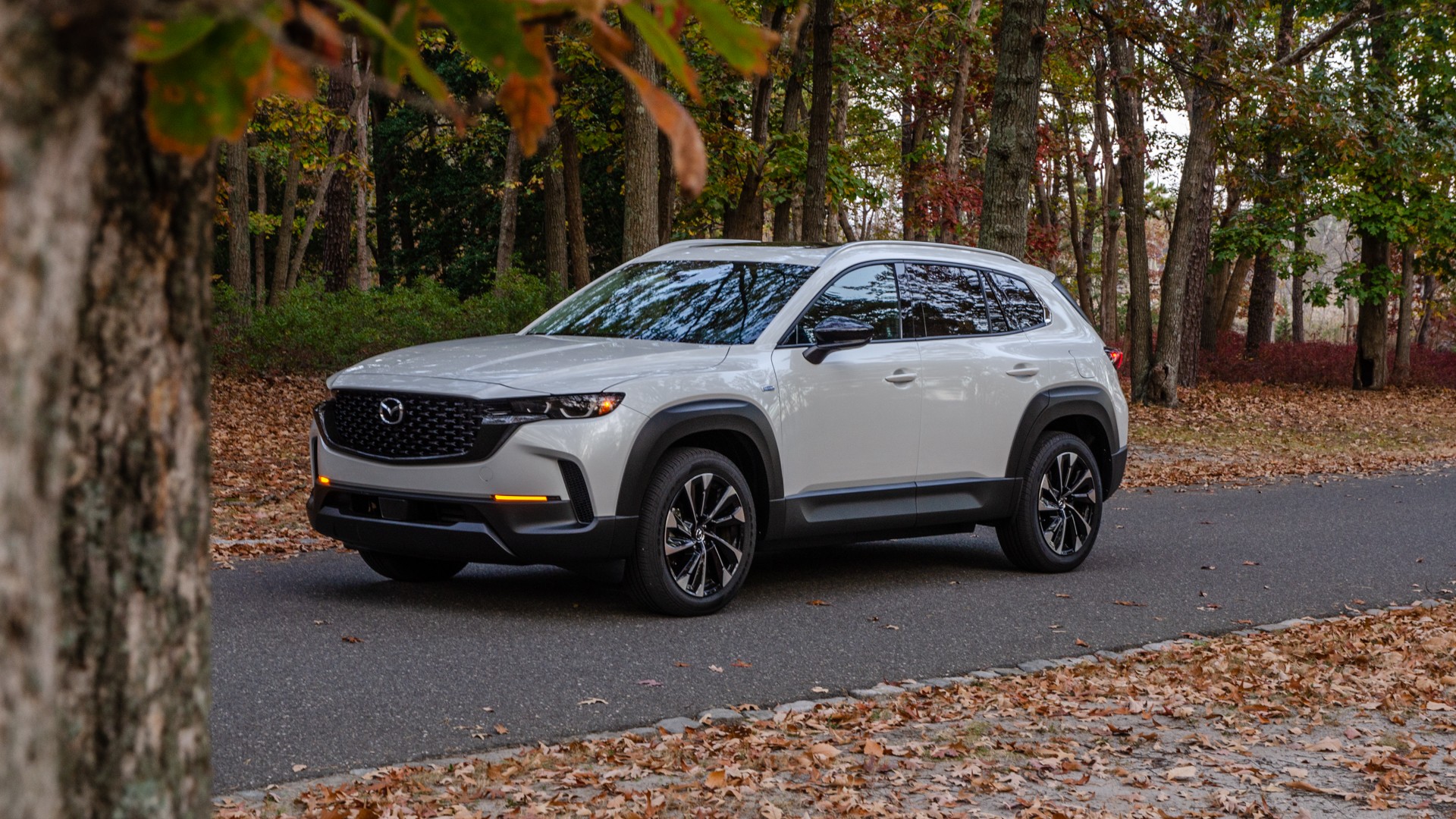 Mazda CX-50 Hybrid cornering on a paved road
Mazda CX-50 Hybrid cornering on a paved road
Highs and Lows
The Mazda CX-50 stands out in the crossover segment for its engaging driving experience. Few competitors offer the same level of steering feel, suspension sophistication, and overall handling balance. It’s clear that Mazda’s DNA, also found in the MX-5 Miata, is present in the CX-50’s driving dynamics. The main gauges are another highlight, praised for their simplicity and readability, even if they lack the high-tech flash of some modern systems. The seats strike a good balance between lateral support for spirited driving and long-distance comfort. However, these positive attributes are shared with the non-hybrid CX-50 models.
On the downside, beyond the hybrid powertrain issues, the infotainment screen is a significant drawback, feeling outdated in today’s market. While the inclusion of wireless Apple CarPlay is a welcome feature, its usability is hampered by Mazda’s rotary scroll wheel interface. While rotary controls were once favored in systems like BMW’s iDrive and Audi’s MMI, Apple CarPlay is not designed for such interfaces, making it less intuitive and somewhat cumbersome to use in the CX-50.
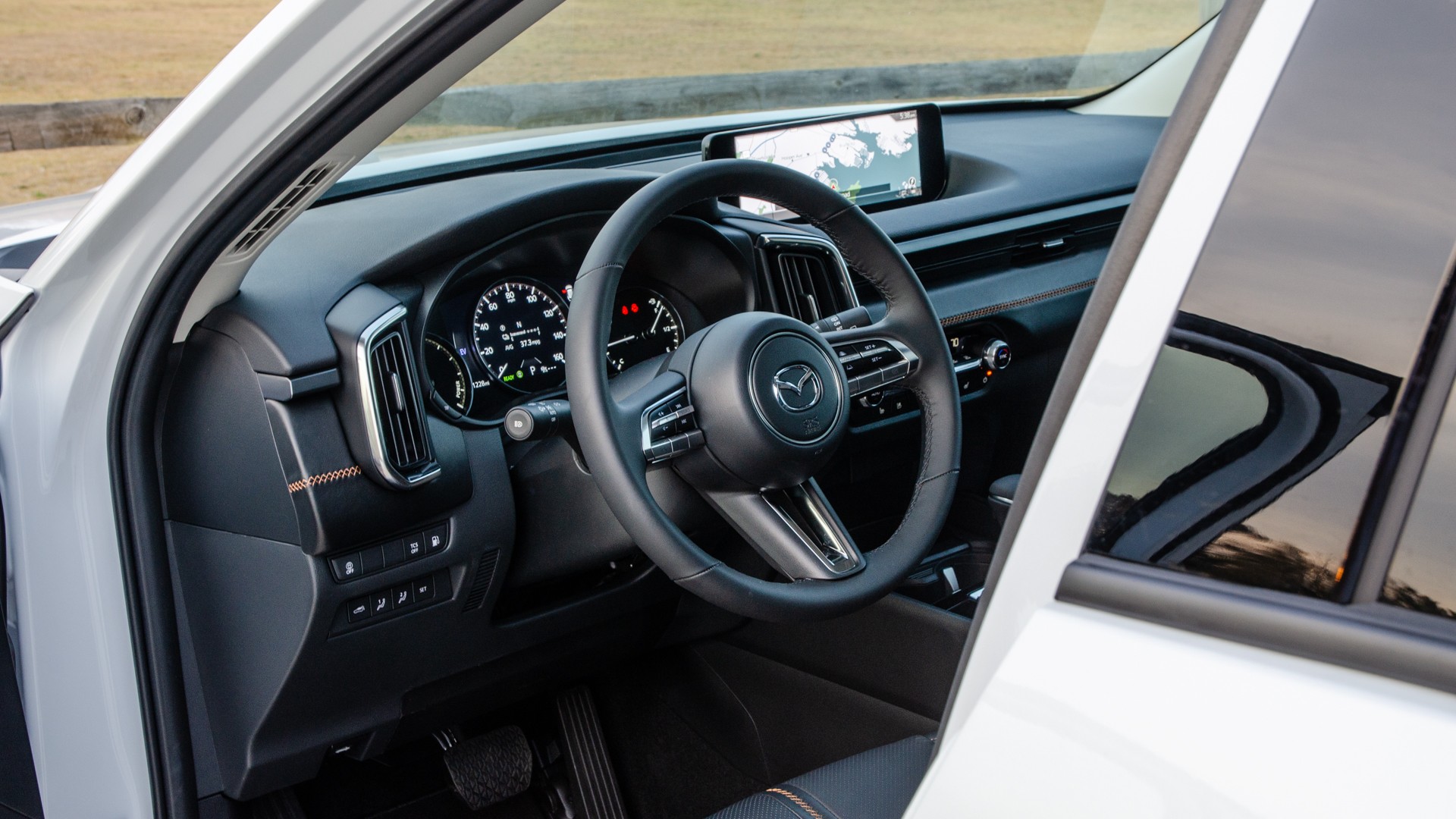 Mazda CX-50 Hybrid interior infotainment system and controls
Mazda CX-50 Hybrid interior infotainment system and controls
Mazda CX-50 Hybrid Features, Options, and Competition
A notable advantage of the Hybrid model is its standard all-wheel-drive configuration. Interestingly, the standard paint options deviate from the typical white and black, instead offering blue and black at no extra cost. This unusual choice might reflect a more adventurous approach to standard options.
The test vehicle was the top-tier Premium Plus trim, which comes with a substantial price premium. However, it includes desirable features such as a panoramic sunroof, 19-inch wheels, a Bose 12-speaker sound system, heated leather seats, and a heated steering wheel. While the as-tested price of nearly $42,000 may seem steep given the CX-50 Hybrid’s power and performance limitations, the equipment level leaves little to be desired in terms of features.
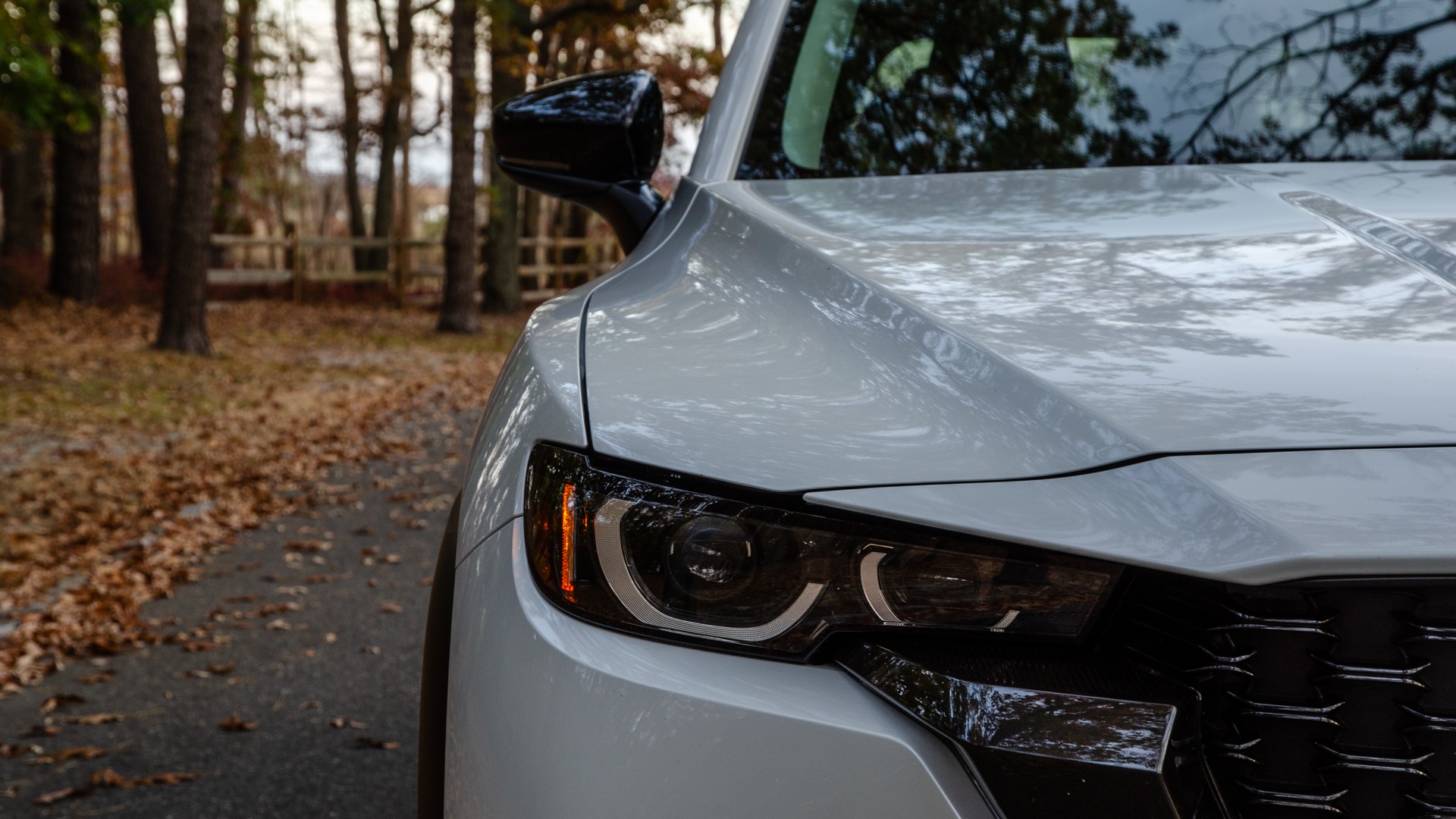 Mazda CX-50 Hybrid exterior wheel detail and sunroof
Mazda CX-50 Hybrid exterior wheel detail and sunroof
The most direct competitor is the Toyota RAV4 Hybrid, sharing the same powertrain and a similar price range. The RAV4 Prime plug-in hybrid, while pricier, offers a significantly more potent plug-in hybrid system. The Honda CR-V Hybrid is also a strong contender, boasting a more responsive powertrain and more modern technology, although it may not match the CX-50’s handling prowess. The Hyundai Tucson Hybrid also exists as another option in this competitive segment.
Fuel Economy
Fuel efficiency is a primary motivation for choosing a hybrid vehicle, and the Mazda CX-50 Hybrid is designed with this in mind. While not intended for outright speed or aggressive driving, its focus is on maximizing fuel economy. Official EPA figures were not yet available at the time of review, but the observed 37 mpg in testing aligns closely with Mazda’s estimated figures of 39 mpg city, 37 mpg highway, and 38 mpg combined.
These figures position the CX-50 Hybrid competitively within its segment, on par with hybrid versions of the Honda CR-V, Toyota RAV4, Hyundai Tucson, and Ford Escape.
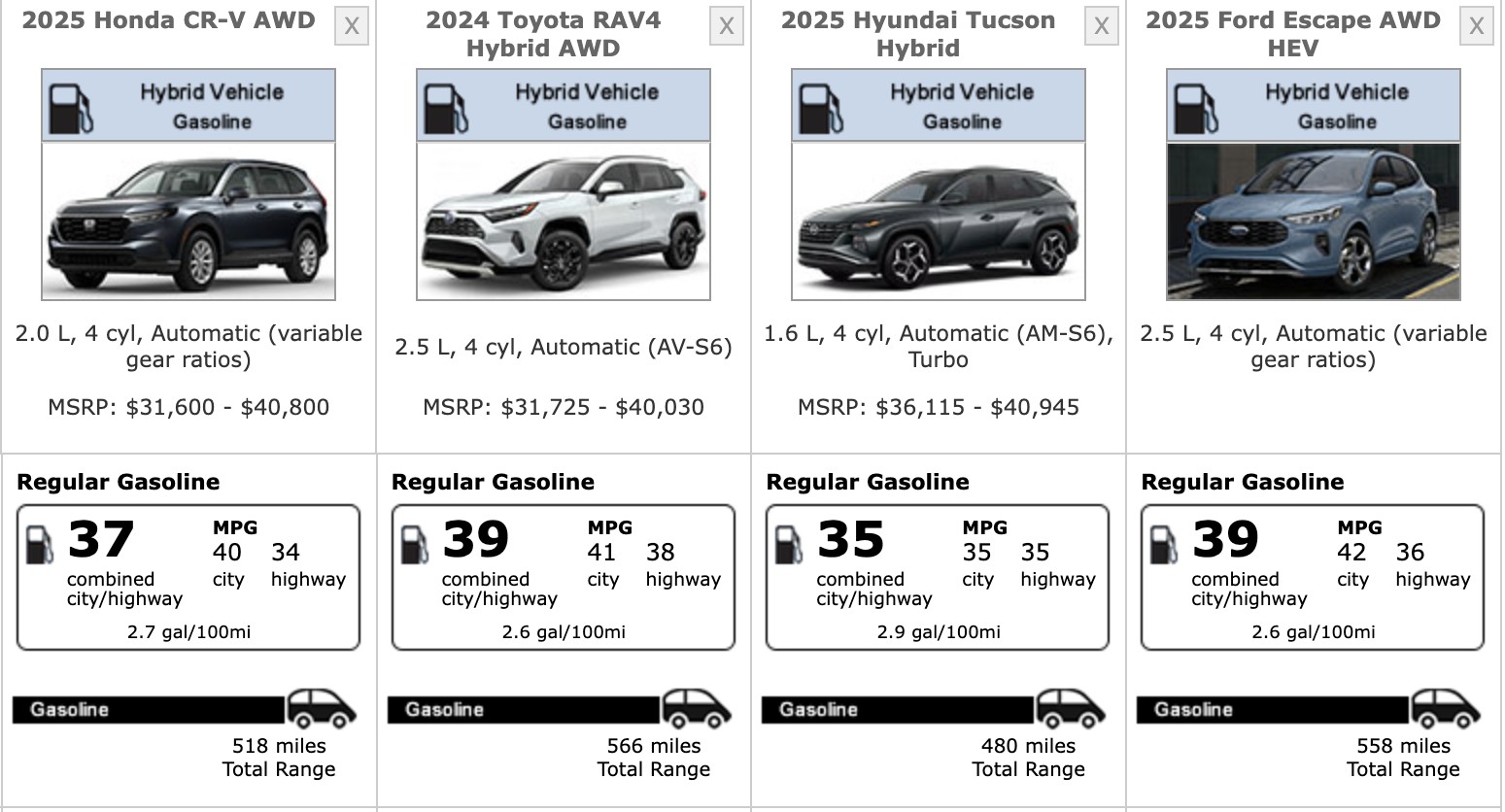 EPA Fuel Economy Comparison Screenshot
EPA Fuel Economy Comparison Screenshot
Value and Verdict
The 2025 Mazda CX-50 Hybrid presents a questionable value proposition, despite being only marginally more expensive than the standard gas model. While it achieves superior fuel efficiency compared to the regular CX-50, other hybrid crossovers in the same price range offer both better fuel economy and more advanced technology. For buyers prioritizing a hybrid powertrain, there are arguably more compelling alternatives available, including models that utilize the same hybrid system.
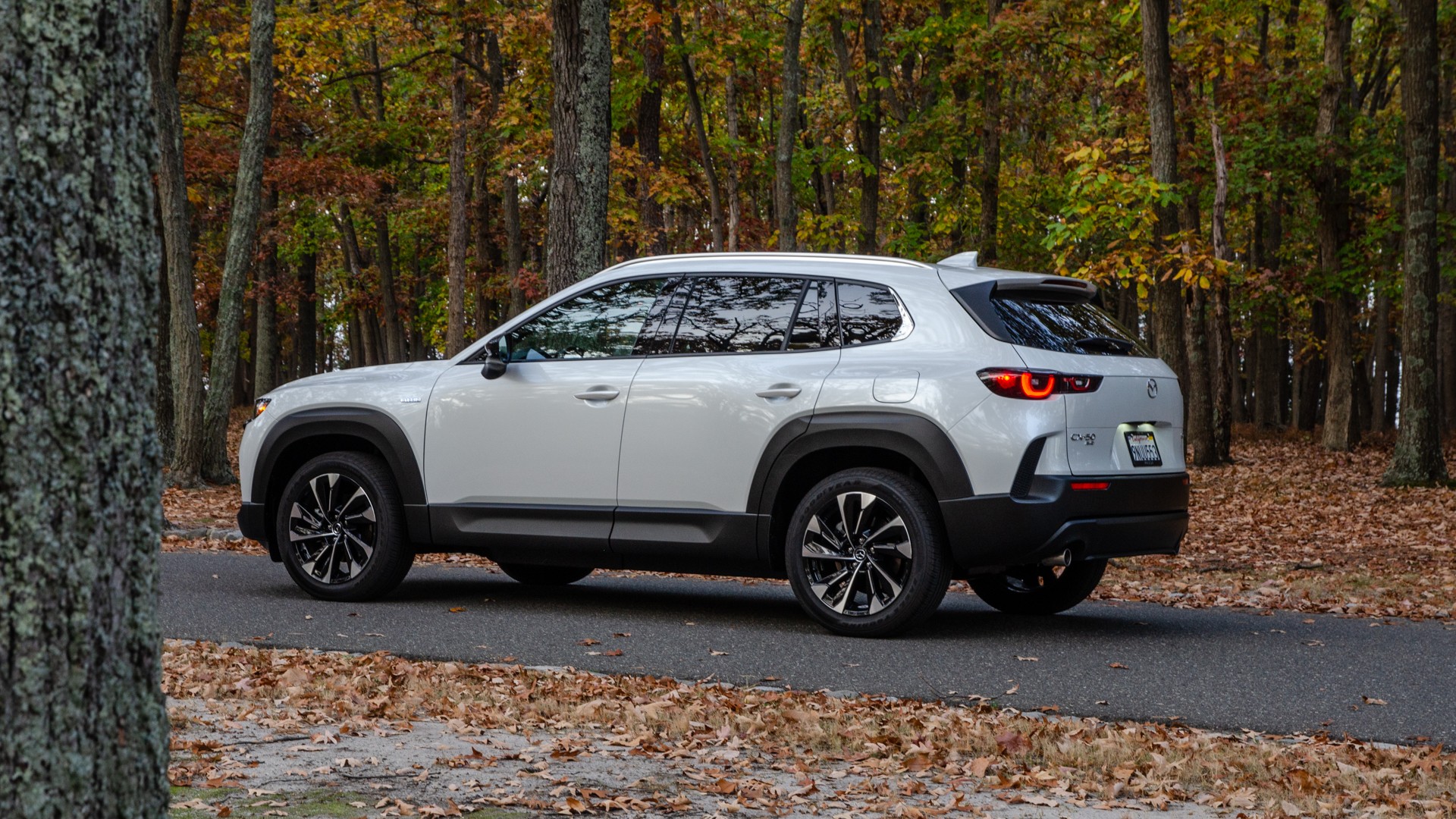 Mazda CX-50 Hybrid rear view
Mazda CX-50 Hybrid rear view
It seems the CX-50 Hybrid aims to blend the engaging driving dynamics of the CX-50 with the efficiency of a hybrid system. However, the integration of the hybrid powertrain appears to compromise the very characteristics that make the CX-50 appealing to driving enthusiasts. The result is a vehicle that feels somewhat conflicted, perhaps fulfilling a market demand for a hybrid option but not fully capturing the spirit of the CX-50.
| 2025 Mazda CX-50 Hybrid Specs |
|---|
| Base Price (Premium Plus as tested) |
| Powertrain |
| Horsepower |
| Torque |
| Seating Capacity |
| Cargo Volume |
| Curb Weight |
| Max Towing |
| Fuel Economy |
| Quick Take |
| Score |